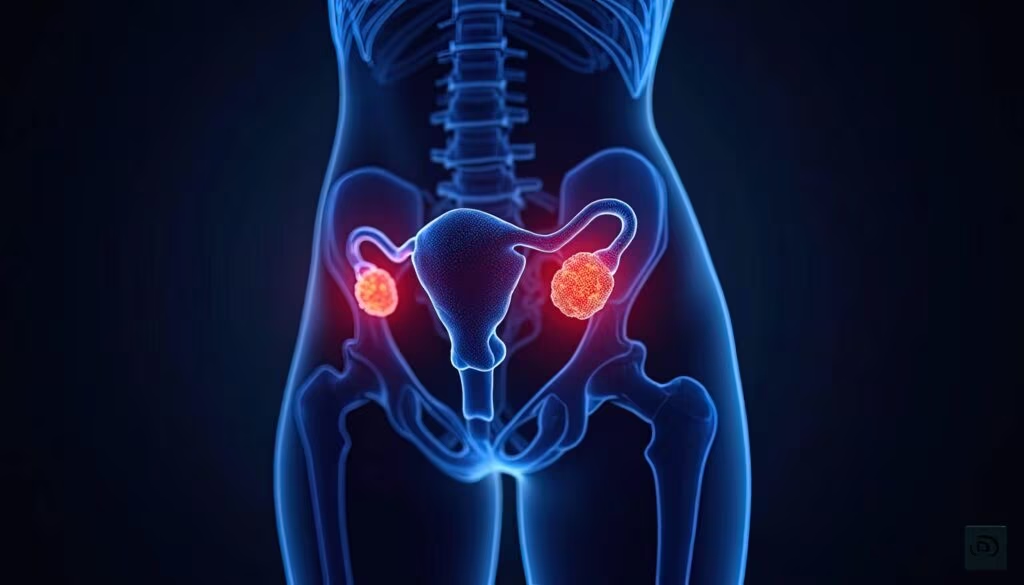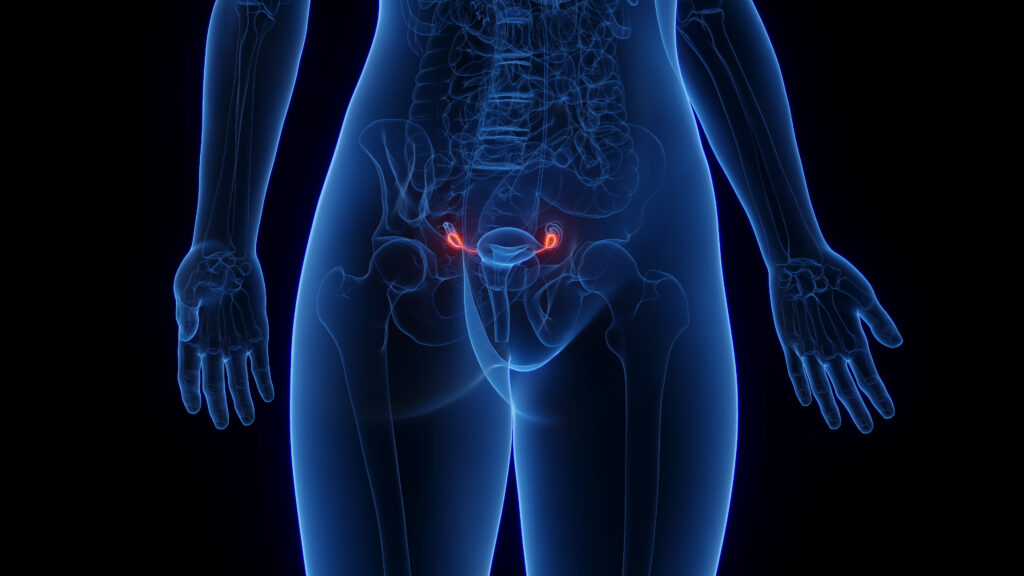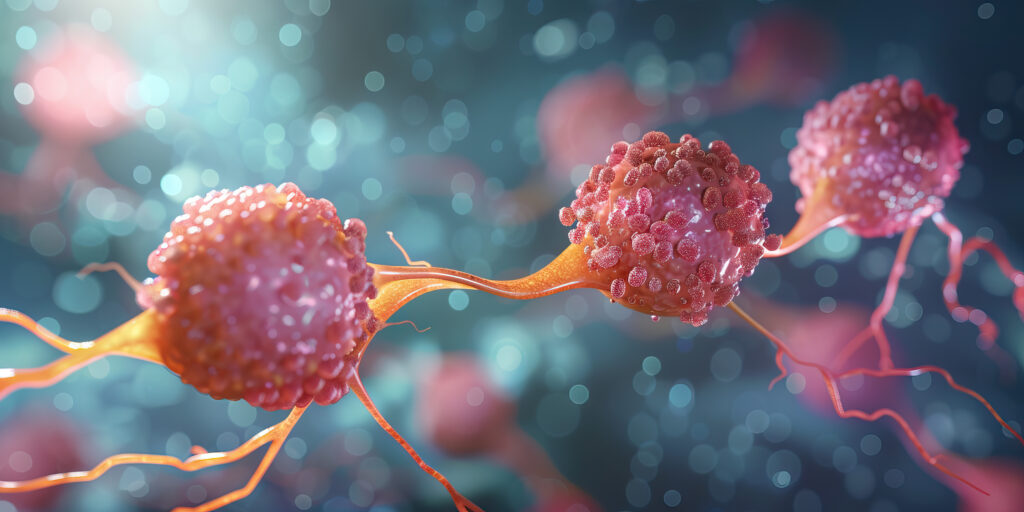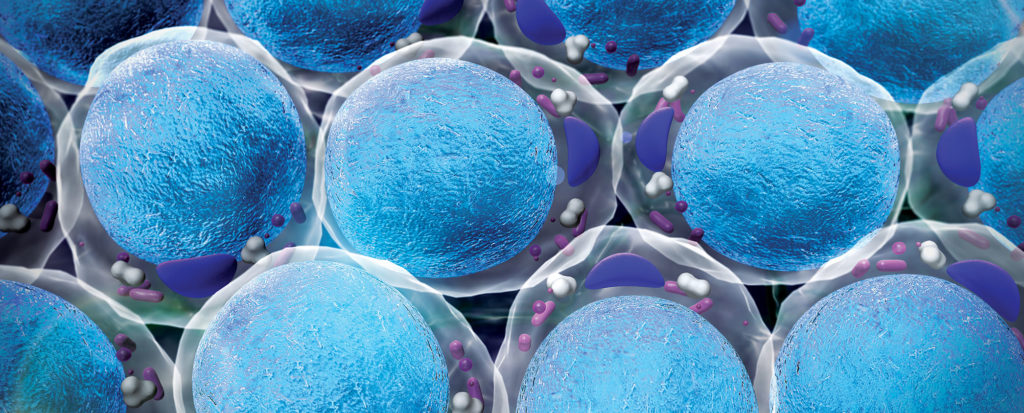Physiology of Normal Penile Erection
Physiology of Normal Penile Erection
Penile erection is a complex hemodynamic event that involves a combination of local, humoral, and neural factors. A key step in the signaling pathway is the release of NO from nitrergic nerves via neuronal nitric oxide synthase (nNOS), combined with the release of endothelial NO via endothelial nitric oxide synthase (eNOS) following penile engorgement and shear stress. The NO-mediated catalysis of guanosine triphosphate (GTP) to cyclic guanosine monophosphate (cGMP) via interaction with the hemoprotein-soluble guanylate cyclase (sGC) is a key step in the pathway. Peripherally, this culminates in the relaxation of the corpus cavernosum smooth muscle and penile vasculature, resulting in increased bloodflow into the trabecular network and sinusoidal spaces. Subsequent compression of the subtunical venules reduces the venous outflow from the corpus cavernosum and maintains tumescence (see Figure 1).
Smooth muscle relaxation via cGMP is likely to involve several mechanisms, including inhibition of L-type Ca2+ channel,3 activation of Ca2+-dependent K+ channels resulting in hyperpolarization and, finally, inhibition of the IP3 receptors located on the sarcoplasmic reticulum.4–6 Subsequently, cGMP-specific PDE catalyze the hydrolysis of cGMP to 5GMP, leading to detumescence.
Although NO-mediated smooth muscle relaxation accounts for the predominant pathway involved in penile smooth muscle relaxation, human corpus cavernosum can also synthesize and metabolize prostanoids, of which PGE1 and PGE2 mediate smooth muscle relaxation by increasing intracellular cyclic adenosine monophosphate (cAMP) levels.
Risk Factors and the Role of Endothelial Dysfunction in Erectile Dysfunction
Erectile dysfunction is conventionally subclassified into organic and psychogenic factors. Organic factors are further subdivided into vasculogenic, neurological, and endocrine disorders, of which vasculogenic erectile dysfunction is the most common. Specific risk factors for erectile dysfunction include ageing, diabetes, smoking, hyperlipidemia, and hypertension. A longitudinal study of 401 men from the MMAS has reported that smoking in particular has been shown to be associated with disease progression.7
As these risk factors are also common to coronary artery disease, the concept of endothelial dysfunction has developed, which considers erectile dysfunction as another manifestation of vascular disease—albeit specific to small-vessel disease. Endothelial dysfunction due to an abnormality in the synthesis and release of NO is associated with vasoconstriction, coagulation, leucocyte adhesion, and smooth muscle cell hyperplasia, which is central to the process of atherogenesis. Endothelial NOS inhibition (via impaired hydrolysis of dimethyl arginine) and the uncoupling of eNOS activity increases the oxidative stress in the endothelial cells, with further oxidative catabolism of NO and formation of peroxynitrite.
The presence of common risk factors in erectile dysfunction and atherogenesis, combined with the proposed pathogenesis of endothelial dysfunction, has now led to clinicians describing erectile dysfunction as a predictive risk factor for coronary artery disease.8 The difference is that the small-calibre penile vasculature is affected before the larger coronary vessels, with endothelial dysfunction being a common denominator.Therapeutic Options for Erectile Dysfunction Lifestyle Modifications
The identification of specific risk factors associated with erectile dysfunction provides an opportunity for conservative measures in patients with mild to moderate erectile dysfunction. Cessation of smoking, weight loss, and exercise are associated with an improvement in erectile function, as well as improving endothelial function and reducing long-term cardiovascular risk.9
Oral Pharmacotherapies
Oral pharmacotherapies have become the first-line option in the management of erectile dysfunction. Provided that there are no contraindications, the lack of invasiveness makes this an ideal first-line option in the majority of patients.
Phosphodiesterase Type 5 Inhibitors
There are currently three PDE-5 inhibitors approved and available for clinical use. The underlying mechanism of action is the same, but they differ in the pharmacokinetics and the selectivity for PDE-5 inhibition. The selectivity for PDE5 inhibition is measured by the median inhibition concentration (IC50), which is the concentration of the drug required to inhibit 50% of the enzyme activity. There are 11 PDE subtypes, and non-selective inhibition of alternative PDE subtypes results in side effects such as visual disturbance (PDE-6).
Sildenafil was developed in 1998 as the first selective PDE-5 inhibitor (IC50 3.5nM). The time to onset is 30–60 minutes and the half-life of sildenafil citrate is 4–5 hours. It is recommended that sildenafil should be taken on an empty stomach, and patients are encouraged to use it on at least eight occasions before considering alternative options. A large number of clinical studies have reported on the efficacy of sildenafil in erectile dysfunction.10,11 Although the original studies were predominantly company-sponsored, data from 11 pooled double-blind trials involving 1,329 patients receiving placebo and 1,338 patients receiving sildenafil resulted in a higher incidence of successful erections in the sildenafil group regardless of the etiology.12 A further meta-analysis from the pooled results of 14 parallel-group dosing trials showed that sildenafil treatment resulted in a higher percentage of successful intercourse attempts than did placebo (57% versus 21%, respectively; n=2,283).13
In 2003, two alternative PDE-5 inhibitors were approved—tadalafil (IC50 0.9nM) and vardenafil (IC50 0.7nM). Comparison of the IC50 values (see Table 1) shows that vardenafil is highly selective for PDE-5 compared with the alternative agents, although this does not necessarily translate into a major difference in the efficacy and overall clinical response. Tadalafil has a half-life of 17.5 hours, which allows for greater spontaneity after drug administration. Vardenafil has a half-life of 4.5 hours, but appears to have a marginally more rapid onset of action. Clinically, there is very little difference between these agents in terms of erectile response, and the main contraindication to all of them is concomitant nitrate use by the patient, which can cause significant hypotension. However, independent comparator trials are still required in order to objectively assess whether there is any clinical advantage of one agent over another.
*Denotes ratio of IC50 for particular PDE enzyme subtype to IC50 for PDE-5.IC50 values obtained from in vitro studies.
Further Developments in the Use of Phosphodiesterase Type 5 Inhibitors
Due to the longer half-life of tadalafil, there has been much interest in the potential benefits of regular dosing schedules. SURE (Scheduled Use versus on-demand Regimen Evaluation), a large, multicenter, international cross-over and open-label study, compared three-times-a-week dosing of tadalafil 20mg to on-demand dosing.14 The overall analysis of 4,262 men first demonstrated the safety of regular dosing, but did not show any statistically significant difference in terms of efficacy (international index of erectile function (IIEF) score) between the two groups. Fifty-seven percent of men preferred the on-demand dosing schedule. Reports from individual countries involved in the trial have shown some variation. In Italy, 1,058 men (59%) preferred on-demand dosing, although there was a greater benefit in IIEF scores with regular dosing—though this was not significant.15 In Spain there was a similar result, with equal efficacy but preference for on-demand dosing.16 One of the most frequent indications for the prescription of a PDE-5 in the US is impotence post-radical prostatectomy. Evidence is mounting that the early use of oral or intracavernosal therapy (so-called ‘rehabilitation’) can give higher rates for the return of spontaneous erections and an improved response to drug therapy in the longer term.17,18
Testosterone Replacement Therapy
Androgens are involved in the central and peripheral pathways associated with penile erection. Testosterone is required for NOS expression in the corpus cavernosum and also for the maintenance of the neural pathway. Although debatable, testosterone supplementation is justifiable in patients with erectile dysfunction who are non-responders to PDE-5 inhibitors and have a low serum testosterone level.19,20 One study has shown that 58% of non-responders converted to responders following combination treatment.21
Alternative Oral Treatment Options Apomorphine
The paraventricular nucleus (PVN) in the hypothalamus is involved in initiating the erectile response. Apomorphine hydrochloride is a dopaminergic receptor agonist (D1 and D2 receptors) that has been developed as a sublingual agent to activate oxytocinergic neurons in the PVN. The median onset to action is 19 minutes and the half-life is one hour. An open-label, randomized, flexibledose comparison of apomorphine and sildenafil demonstrated the superior efficacy of sildenafil to apomorphine (75% versus 35%, respectively).22 The side effect profile—nausea (7%), dizziness (6.5%), and yawning (8.1%)— combined with a high non-responder rate has limited the therapeutic acceptance of this drug and has led to its withdrawal. a-adrenoceptor Antagonists
The aim of these agents is to reduce the corpus cavernosum smooth muscle tone by inhibiting the innervation of the sympathetic nervous system. These agents are not routinely used in clinical practice as we now know that the NO–cGMP signaling system is the predominant pathway in achieving smooth muscle relaxation.
Yohimbine is an orally administered indolalquinolonic alkaloid agent with both peripheral a2 adrenergic receptor blockade and central noradrenergic agonist activity. Phentolamine is a non-selective á-adrenoceptor antagonist, but has not gained acceptance—partly due to the associated systemic hemodynamic effects. The selective a1 antagonists doxazosin and terazosin are routinely utilized for patients with bladder outflow obstruction and can improve erectile function in patients with mild symptoms.
Intracavernosal and Intraurethral Prostaglandins
The synthetic PGE1 analog alprostadil can be administered as a second-line therapy in those who have failed oral pharmacotherapies or have a specific contraindication to treatment with oral agents. PGE1 increases the intracellular concentrations of the second messenger cAMP, resulting in corpus cavernosum smooth muscle relaxation. Currently, two methods of administration are available: direct intracavernosal injection (80% response rate) or intraurethral application of a small pellet (MUSE® dose 250–1,000ìg, 65% response rate). This second-line treatment is useful in patients with long-standing diabetes or erectile dysfunction secondary to pelvic surgery, who have a higher incidence of erectile dysfunction refractory to oral pharmacotherapies.
Mechanical Interventions Vacuum Devices
These devices are useful in patents with psychogenic or organic erectile dysfunction and can be used alone or in combination with other therapies. An external cylinder is utilized to create a negative pressure and penile tumescence is maintained by means of a constriction ring at the base of the penis. The reported patient satisfaction rate is 50–70%.23Insertion of Penile Prosthesis
The insertion of a penile prosthesis is suitable for patients with severe organic erectile dysfunction. Two main subtypes of prosthesis are available: malleable (or semi-rigid) and inflatable. The malleable devices have the advantages of decreased mechanical breakdown, easier placement, and lower cost. Inflatable devices are available as one-, two-, or three-piece devices. The two- and three-piece devices have a pump placed in the scrotum that controls the inflation and deflation of the device and therefore requires an element of patient dexterity. Complications include infection rates of up to 2–3% and re-operation rates for mechanical failure of 15% by 10 years. Recently, overall satisfaction rates have been reported as 85% and 76% from the patients and partners, respectively, using a two-piece inflatable prosthesis.24
Vascular Surgery
Penile revascularization surgery has a limited role and is most suitable in young patients without additional risk factors for endothelial dysfunction. It may be of particular benefit in those who have suffered pelvic fractures with arterial injury. In carefully selected patients, a significant improvement at five years may be seen in up to 65% of patients.25
Future Therapeutic Options Rho-kinase Inhibitors
Rho-A is a small monomeric G protein that activates rho-kinase and is involved in the sensitization of the smooth muscle contractile elements to Ca2+. Therefore, smooth muscle relaxation can be modulated without a change in the intracellular Ca2+ levels. Rho-kinase inhibitors provide an alternative pathway to produce smooth muscle relaxation and in vitro studies have shown that specific inhibitors of rho-kinase such as Y-27632 can cause a concentration-dependent relaxation of corpus cavernosum.26
Direct Soluble Guanylate Cyclase Activators
Patients with significant endothelial dysfunction or nitrergic nerve impairment are unable to produce adequate endogenous NO. Therefore, direct NO-independent activation of sGC provides a novel approach. The benzylindazole derivative YC-1 has been investigated as a potential sGC activator, but has been found to have non-specific phosphodiesterase inhibitory activity—although alternative compounds based on this prototype have been developed and are under investigation.27Nitric Oxide-releasing Phosphodiesterase Type 5 Inhibitors
Sildenafil nitrate is an NO-releasing derivative of sildenafil citrate that can release NO spontaneously and can also inhibit PDE-5. This compound is more potent than sildenafil citrate and can release NO in the absence of endogenous NO. Further research is required before any clinical application is proposed.28
Melanotan II
Melanotan II is a non-selective melanocortin receptor agonist that mimics the action of adrenocorticotropic hormone (ACTH) and alpha-melanocytestimulating hormone (MSH). When given subcutaneously it has been found to give spontaneous erections, but it has not yet been developed into a commercially available product.
Combination Therapies
Combination treatment with simultaneous use of either PDE-5 inhibitors and intracavernosal agents or apomorphine has not yet been fully investigated, but may have a role in patients in difficult treatment groups such as diabetics or those having had previous pelvic surgery.
Gene Therapy
The lack of efficacy (up to 50%) of PDE-5 inhibitors in certain groups of patients such as diabetics and post-radical prostatectomy patients has led to the i
vestigation of gene therapy for the treatment of erectile dysfunction. The intracavernosal injection of a vector to alter protein expression is a possible therapeutic option in treatment failures. Possible targets in the pathway include restoration of the endothelial and neuronal NO release, K+ channel openers to increase hyperpolarization, growth factor upregulation to increase eNOS and nNOS expression, and modulation of the RhoA/rho-kinase pathway. Whether gene therapy can be used locally in the penis or synergistically with PDE-5 inhibitors is still under investigation. A phase I trial with an intracavernous injection of a plasmid vector (hMaxi-K) has been performed and initial reports have found this to be safe.29
Conclusions
With a better understanding of the underlying pathophysiology of erectile dysfunction, combined with the development of PDE-5 inhibitors, major advances have been made over the last two decades in treating an increasingly common male condition. The common denominator of endothelial dysfunction in erectile dysfunction and vascular disease has now led to clinicians using erectile dysfunction as an early cardiovascular risk factor. Although PDE-5 inhibitors have high efficacy rates, there is still a significant number of non-responders in the diabetic population. This is one patient subgroup where further drug development is required.












